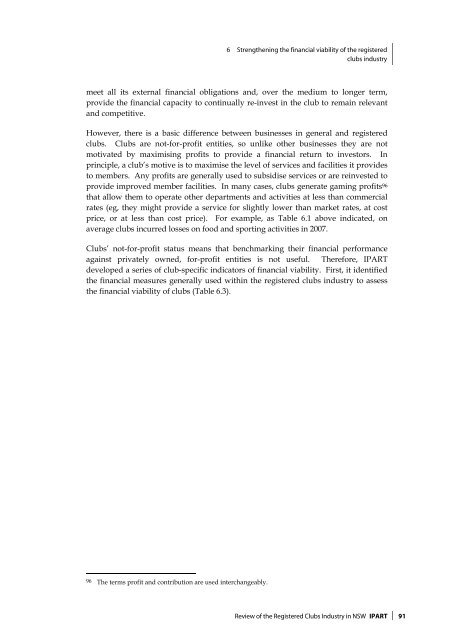Review of the Registered Clubs Industry in NSW - Clubs NSW
Review of the Registered Clubs Industry in NSW - Clubs NSW
Review of the Registered Clubs Industry in NSW - Clubs NSW
You also want an ePaper? Increase the reach of your titles
YUMPU automatically turns print PDFs into web optimized ePapers that Google loves.
6 Streng<strong>the</strong>n<strong>in</strong>g <strong>the</strong> f<strong>in</strong>ancial viability <strong>of</strong> <strong>the</strong> registered<br />
clubs <strong>in</strong>dustry<br />
meet all its external f<strong>in</strong>ancial obligations and, over <strong>the</strong> medium to longer term,<br />
provide <strong>the</strong> f<strong>in</strong>ancial capacity to cont<strong>in</strong>ually re-<strong>in</strong>vest <strong>in</strong> <strong>the</strong> club to rema<strong>in</strong> relevant<br />
and competitive.<br />
However, <strong>the</strong>re is a basic difference between bus<strong>in</strong>esses <strong>in</strong> general and registered<br />
clubs. <strong>Clubs</strong> are not-for-pr<strong>of</strong>it entities, so unlike o<strong>the</strong>r bus<strong>in</strong>esses <strong>the</strong>y are not<br />
motivated by maximis<strong>in</strong>g pr<strong>of</strong>its to provide a f<strong>in</strong>ancial return to <strong>in</strong>vestors. In<br />
pr<strong>in</strong>ciple, a club’s motive is to maximise <strong>the</strong> level <strong>of</strong> services and facilities it provides<br />
to members. Any pr<strong>of</strong>its are generally used to subsidise services or are re<strong>in</strong>vested to<br />
provide improved member facilities. In many cases, clubs generate gam<strong>in</strong>g pr<strong>of</strong>its 96<br />
that allow <strong>the</strong>m to operate o<strong>the</strong>r departments and activities at less than commercial<br />
rates (eg, <strong>the</strong>y might provide a service for slightly lower than market rates, at cost<br />
price, or at less than cost price). For example, as Table 6.1 above <strong>in</strong>dicated, on<br />
average clubs <strong>in</strong>curred losses on food and sport<strong>in</strong>g activities <strong>in</strong> 2007.<br />
<strong>Clubs</strong>’ not-for-pr<strong>of</strong>it status means that benchmark<strong>in</strong>g <strong>the</strong>ir f<strong>in</strong>ancial performance<br />
aga<strong>in</strong>st privately owned, for-pr<strong>of</strong>it entities is not useful. Therefore, IPART<br />
developed a series <strong>of</strong> club-specific <strong>in</strong>dicators <strong>of</strong> f<strong>in</strong>ancial viability. First, it identified<br />
<strong>the</strong> f<strong>in</strong>ancial measures generally used with<strong>in</strong> <strong>the</strong> registered clubs <strong>in</strong>dustry to assess<br />
<strong>the</strong> f<strong>in</strong>ancial viability <strong>of</strong> clubs (Table 6.3).<br />
96 The terms pr<strong>of</strong>it and contribution are used <strong>in</strong>terchangeably.<br />
<strong>Review</strong> <strong>of</strong> <strong>the</strong> <strong>Registered</strong> <strong>Clubs</strong> <strong>Industry</strong> <strong>in</strong> <strong>NSW</strong> IPART 91
















